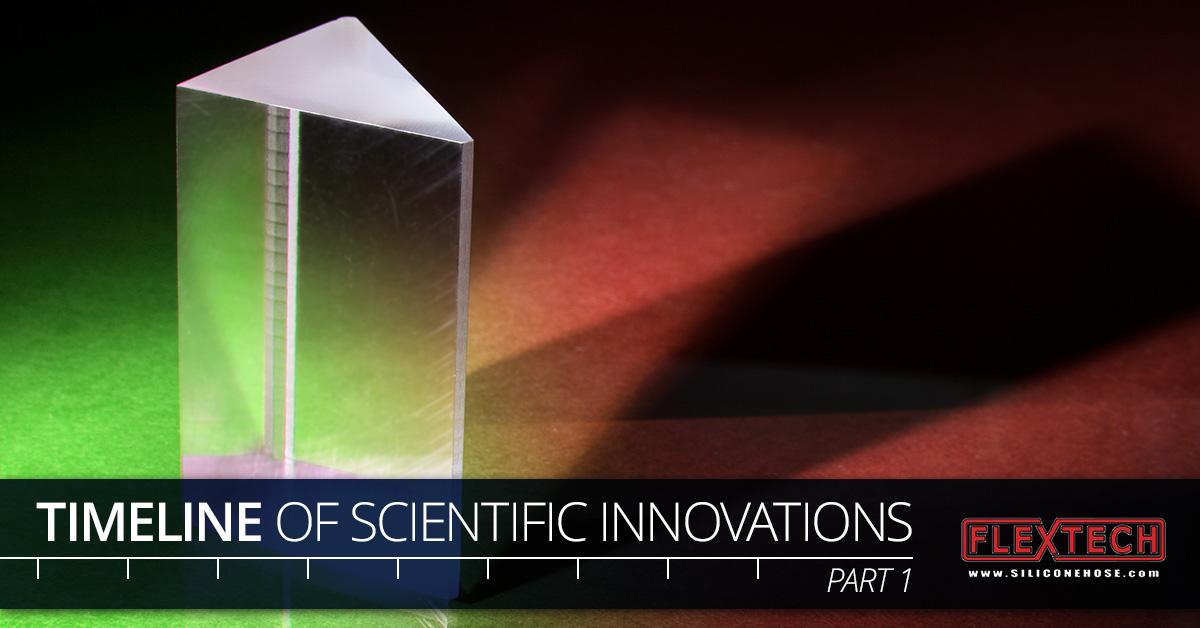
Here at Flex Technologies, we are all about innovation with our silicone products that we manufacture and sell online. But to innovate in today's world is to stand on the shoulders of giants. That's because we enjoy a fast-tracked education to the scientific gains that millions have sacrificed before us. In order to honor the scientific innovators of the past, we've presented a timeline of great scientific discoveries here.
4th and 3rd Centuries BCE
While science as a discipline wouldn't exist for centuries, there were scientific gains made in this time period, mostly in the field of medicine and cosmology. Human beings were only beginning to understand the world around them, having barely mastered agriculture.
- In the 4th century BCE, Theophrastus discovered that the Madragora (Mandrake root), which we know contains atropin, could be used to treat wounds, gout, and sleeplessness. His work became widely accepted, and by the first century BCE, wine distilled from the Mandrake root was considered an anesthetic by doctors such as Dioscorides.
- Aristarchus of Samos is one of the first philosophers to promote a heliocentric and heliostatic model. Nowadays, we know that our solar system is heliocentric. However, this wouldn't become common knowledge again after Aristarchus' time until Copernicus and Galileo would risk their lives for the theory. Aristarchus was incorrect about the the universe being heliostatic, however, as we all know the sun also moves through space.
2nd Century BCE to 10th Century
Nowadays, we can safely say that human progress and scientific achievement tends to increase exponentially. But thousands of years ago, that would not have seemed the case. People just did not have the resources or time to create new innovations in the harsh world, so innovators like the following were more rare. However, towards the end of this period there was a great Muslim enlightenment, where more innovations were discovered than ever before, which laid the groundwork for the European enlightenment centuries later and is the bedrock to much of our modern thinking.
- Some time in the 150s BCE, Seleucus of Seleucia (naming conventions were fun back then) made the pivotal discovery that the tides were caused by the moon. Just think, before then any number of supernatural explanations must have been made for the tide, but once a worldly cause was found, entire new possibilities in the areas of sailing and fishing must have opened up.
- Al-Battani, a noted historic innovator, contributed to the Tables of Toledo some time around the 9th century. These charts were used by astronomers of the time to chart and predict the movements of the sun, moon, and planets in the sky. Copernicus would use this very chart centuries later to perfect his own understanding of the cosmos.
- In 984, Ibn Sahl becomes the first person to describe what would later be known as Snell's law of refraction. This is a formula used to describe how light refracts at different angles of incidence.
- In the 10th century, Muhammad ibn Zakariya al-Razi was the first person in recorded history to discover the cause of the measles and smallpox. He is also credited with discovering uses for kerosene and distilled petroleum.
11th to 14th Century
Islamic enlightenment would continue all the way through the 14th century. Because of that, most of these entries on Part 1 of this series will be from that cultural area. Who knows how many centuries we would be behind on progress without these great thinkers to pave the way.
- One of these major achievements was the first recorded controlled experiment with results that could be reproduced. These were recorded in the Book of Optics by Ibn al-Haytham in 1121.
- Around the same time, Ibn Bajjah discovered the principles of reaction. This was essentially the precursor to Isaac Newton's third law of motion, which would not be presented until the 1600s.
- In 1054, the first ever supernova was observed and recorded (the modern designation for this supernova is SN 1054). Modern astronomers have poured through descriptions of the event, and believe the supernova happened in the Crab Nebula.
- Late in the 11th century, a Chinese scientist named Shen Kuo discovered two important concepts. The first one, true north, became an integral tool for travelers all across the world for thousands of years (anybody who uses a compass uses this concept).
- Al-Khazini made major contributions to the concept of gravity in the early twelfth century. He was the first person to record a change in gravitation and gravitational potential energy in respect to distance. He was also the first person recorded to ever notice the decrease in air density as you gain in altitude.
- In the 13th century, famed Ibn al-Nafis would discover both the concepts of pulmonary circulation and our circulatory system. Naturally, this had huge effects on the progress of medicine in the future.
- Also in the 13th century, Theodoric of Freiberg became the first person to correctly explain the phenomenon of a rainbow (the refraction of white light).
- William of Saint Cloud was another 13th century innovator who became the first person ever to use a camera obscura to safely view a solar eclipse.
Hopefully this timeline of scientific innovation proved interesting. Stay tuned for Part 2, where we really get the ball of scientific innovation rolling. We are proud to stand on the shoulders of such scientific genius with every silicone product innovation we apply, and we are constantly working on ways to improve our silicone manufacturing processes. For more information on the innovative silicone products we sell online, please do not hesitate to give us a call at your earliest convenience. One of our friendly and knowledgeable representatives will be happy to answer any questions that you may have.
 Default Currency
Default Currency
 Mexican Pesos
Mexican Pesos
 Canadian Dollar
Canadian Dollar



